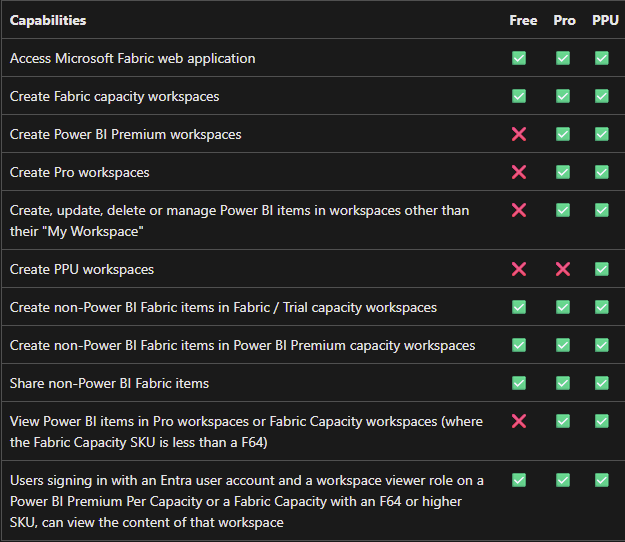

Microsoft's Finance Data and Experiences (FD&E) team reduced report processing times by two-thirds, delivering insights five hours faster and cutting data generation costs by 50% through the power of Microsoft Fabric.
Similarly, Revenue Grid achieved a 60% reduction in infrastructure costs by leveraging Microsoft Fabric's capabilities.
These examples show that Microsoft Fabric can be the powerhouse that drives your analytics, data science, and engineering all on one platform! But here's the catch—while the platform's capabilities are vast, choosing the right Licensing plan can be a maze of decisions that could either save or cost your business thousands.
This blog will guide you through the essential concepts, options, and best practices for managing Microsoft Fabric’s capacity and Licensing plans effectively.
In Microsoft Fabric, capacity refers to the dedicated or shared compute resources that power your data workloads. These workloads include data ingestion pipelines, data transformation and integration tasks, real-time and batch analytics, AI and machine learning model training, as well as interactive Power BI reporting and dashboarding.
Fabric measures capacity in Capacity Units (CUs), which represent a bundle of CPU, memory, and I/O resources allocated to your environment. Different types and sizes of capacity provide different numbers of CUs and resource allocations.
In contrast to Azure, where each service has its own pricing, Microsoft Fabric simplifies the cost structure by focusing on two key components:

Now that we have established the importance of capacity, it’s time to look at how it’s organized within Microsoft Fabric. Let’s take a deeper look at each of these components and how they influence your Fabric environment.
To effectively manage Microsoft Fabric’s pricing and Licensing, it's important to understand how the platform’s capacity is structured around Tenants, Capacities, and Workspaces. These components help organizations streamline their resources, optimize operational efficiency, and control costs.
Also read: Getting Started with Data Analytics on Microsoft Fabric
By understanding this structure, organizations can allocate resources based on their actual needs, ensuring that they optimize performance while managing costs effectively.
Once you understand the structure of Fabric, the next step is selecting the right Capacity SKU to support your data workflows. Next, we’ll break down these SKUs in more detail to help you determine which is best suited for your organization's needs.
Microsoft offers two main SKU families for capacity, designed to meet varying workload demands and use cases:
When it comes to costs, Microsoft Fabric offers two primary pricing models: Pay-As-You-Go (PAYG) and Reserved Capacity. Each option has distinct advantages, depending on your workload and budget predictability. Now, let’s explore these pricing models in more depth, so you can make the best choice for your business.
Microsoft Fabric capacity is billed primarily under two pricing models, allowing organizations to choose based on usage predictability and cost preferences:
Each Per-user licensing is tailored for specific capabilities as seen in the following table:

Now that we have explored the pricing models, let's take a closer look at how to optimize your capacity by considering these additional elements.
Suggested reading: Microsoft Synapse vs Fabric: Comprehensive Comparison
In the next section, we will break down storage-related expenses and show you how to better manage and optimize your storage usage within Microsoft Fabric.
In Microsoft Fabric, compute capacity does not cover data storage expenses, meaning organizations must account for storage costs separately. These costs are similar to those associated with Azure Data Lake Storage (ADLS), as both are built on similar underlying technologies.
Key costs include:
This breakdown helps organizations better estimate their total storage expenses and avoid unexpected costs.
With capacity and storage under control, it's time to address the core of the matter: best practices.
Choosing the right plan is only the beginning. To maximize the value of your Microsoft Fabric environment, you will need to follow best practices for managing your capacity.

Effectively managing Microsoft Fabric’s capacity ensures optimal performance, cost-efficiency, and seamless scaling as your organization’s data needs grow. Below are key best practices to ensure you are leveraging your resources to the fullest while maintaining control over costs.
One of the most important aspects of managing capacity is selecting the right SKU for your workloads. Overestimating your needs can lead to unnecessary costs, while underestimating may result in performance bottlenecks.
Best Practice:
Continuous monitoring of resource consumption allows you to identify inefficiencies and optimize your usage. Use Microsoft Fabric’s built-in monitoring tools to track key metrics like CPU usage, memory, and storage consumption.
Best Practice:
Auto-scaling ensures that Fabric automatically adjusts capacity in response to fluctuating workloads. This is particularly useful for businesses with variable or unpredictable usage patterns, such as seasonal peaks or project-specific spikes.
Best Practice:
For organizations with predictable, steady-state workloads, reserved capacity offers substantial cost savings. By committing to a one- or three-year term, you can lock in lower rates and optimize your long-term resource planning.
Best Practice:
Workload isolation involves separating different types of workloads (e.g., data engineering, analytics, reporting) into dedicated workspaces or even dedicated capacities. This ensures that critical workloads, such as real-time analytics or mission-critical AI models, do not experience slowdowns due to resource contention.
Best Practice:
Microsoft Fabric relies on OneLake for storage, but managing your data and how it's stored can significantly impact performance and costs. Optimizing your storage strategy, including data partitioning and the use of incremental refresh, helps improve both performance and cost-efficiency.
Best Practice:
As your organization grows and your data needs evolve, it’s important to periodically review your capacity and Licensing. This includes assessing whether your current capacity is still suitable, and whether new capabilities or configurations could offer better performance or cost efficiency.
Best Practice:
Microsoft Fabric provides organizations with flexible, scalable, and efficient data management solutions. By understanding the different capacity-based and per-user Licensing models, organizations can tailor their Licensing strategy to meet their specific needs. Whether you choose the Pay-As-You-Go model for dynamic workloads or reserved capacity for long-term savings, Microsoft Fabric offers the tools necessary to optimize performance and cost-efficiency.
At WaferWire, we don’t just help you integrate Microsoft Fabric, we tailor it to amplify your business’s unique potential. With our expertise in data engineering, analytics, and AI, we ensure that you don’t just use Fabric, but fully leverage it to streamline operations, cut costs, and drive smarter decisions.
Don’t let complexity hold you back. Partner with WaferWire to unlock seamless scalability, smarter workflows, and a data infrastructure that works for you.
Reach out to us today — let’s make Microsoft Fabric work as hard as you do.

